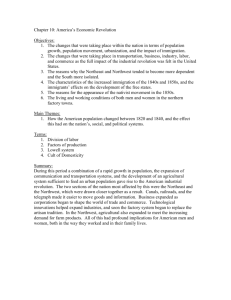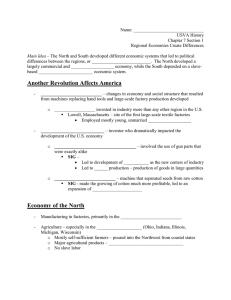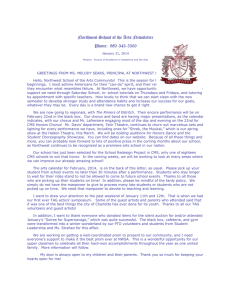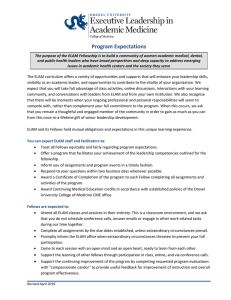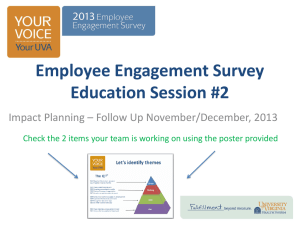Where Children Spend Their Time
advertisement
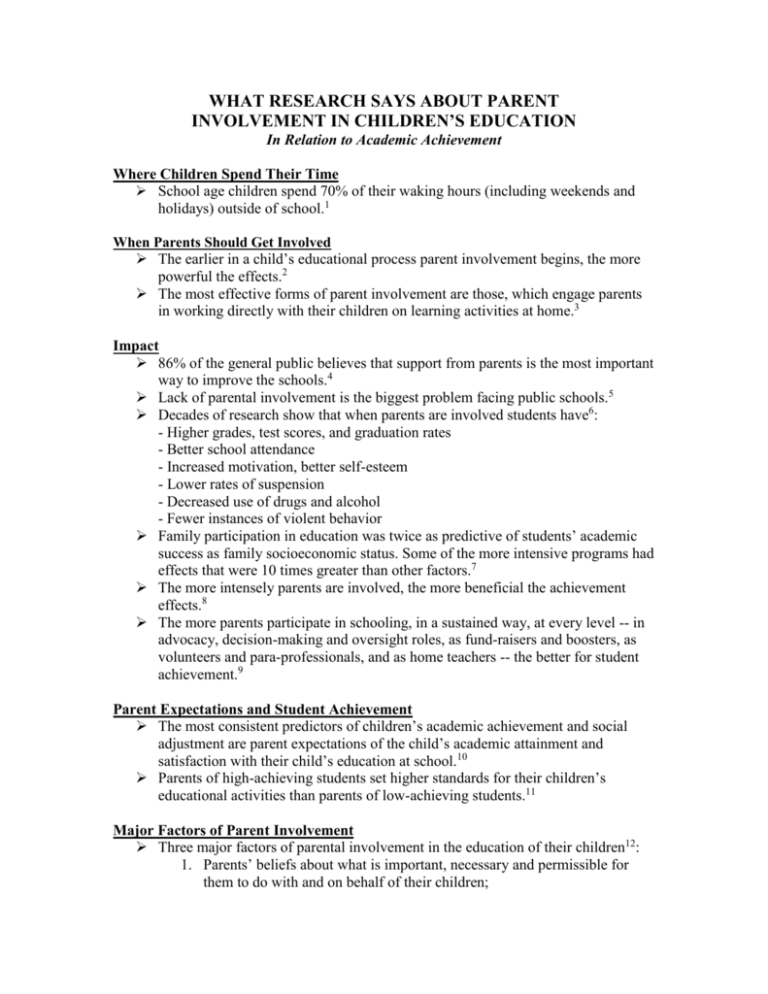
WHAT RESEARCH SAYS ABOUT PARENT INVOLVEMENT IN CHILDREN’S EDUCATION In Relation to Academic Achievement Where Children Spend Their Time School age children spend 70% of their waking hours (including weekends and holidays) outside of school.1 When Parents Should Get Involved The earlier in a child’s educational process parent involvement begins, the more powerful the effects.2 The most effective forms of parent involvement are those, which engage parents in working directly with their children on learning activities at home.3 Impact 86% of the general public believes that support from parents is the most important way to improve the schools.4 Lack of parental involvement is the biggest problem facing public schools.5 Decades of research show that when parents are involved students have6: - Higher grades, test scores, and graduation rates - Better school attendance - Increased motivation, better self-esteem - Lower rates of suspension - Decreased use of drugs and alcohol - Fewer instances of violent behavior Family participation in education was twice as predictive of students’ academic success as family socioeconomic status. Some of the more intensive programs had effects that were 10 times greater than other factors.7 The more intensely parents are involved, the more beneficial the achievement effects.8 The more parents participate in schooling, in a sustained way, at every level -- in advocacy, decision-making and oversight roles, as fund-raisers and boosters, as volunteers and para-professionals, and as home teachers -- the better for student achievement.9 Parent Expectations and Student Achievement The most consistent predictors of children’s academic achievement and social adjustment are parent expectations of the child’s academic attainment and satisfaction with their child’s education at school.10 Parents of high-achieving students set higher standards for their children’s educational activities than parents of low-achieving students.11 Major Factors of Parent Involvement Three major factors of parental involvement in the education of their children12: 1. Parents’ beliefs about what is important, necessary and permissible for them to do with and on behalf of their children; 2. The extent to which parents believe that they can have a positive influence on their children’s education; and 3. Parents’ perceptions that their children and school want them to be involved. Type of Involvement Although most parents do not know how to help their children with their education, with guidance and support, they may become increasingly involved in home learning activities and find themselves with opportunities to teach, to be models for and to guide their children.13 When schools encourage children to practice reading at home with parents, the children make significant gains in reading achievement compared to those who only practice at school.14 Parents, who read to their children, have books available, take trips, guide TV watching, and provide stimulating experiences contribute to student achievement.15 Families whose children are doing well in school exhibit the following characteristics:16 1. Establish a daily family routine. Examples: Providing time and a quiet place to study, assigning responsibility for household chores, being firm about bedtime and having dinner together. 2. Monitor out-of-school activities. Examples: Setting limits on TV watching, checking up on children when parents are not home, arranging for after-school activities and supervised care. 3. Model the value of learning, self-discipline, and hard work. Examples: Communicating through questioning and conversation, demonstrating that achievement comes from working hard. 4. Express high but realistic expectations for achievement. Examples: Setting goals and standards that are appropriate for children's age and maturity, recognizing and encouraging special talents, informing friends and family about successes. 5. Encourage children's development/ progress in school. Examples: Maintaining a warm and supportive home, showing interest in children's progress at school, helping with homework, discussing the value of a good education and possible career options, staying in touch with teachers and school staff. 6. Encourage reading, writing, and discussions among family members. Examples: Reading, listening to children read and talking about what is being read. Student Interest Most students at all levels – elementary, middle, and high school – want their families to be more knowledgeable partners about schooling and are willing to take active roles in assisting communications between home and school.17 When parents come to school regularly, it reinforces the view in the child's mind that school and home are connected and that school is an integral part of the whole family's life.18 Cited in part from (2001) Michigan Department of Education “Decision Making Yardstick 2001”. 1 Clark, R.M. (1990). Why Disadvantaged Children Succeed. Public Welfare (Spring): 17-23. 2 Cotton, K., Wikelund, K., Northwest Regional Educational Laboratory, School Improvement Research Series. In Parent Involvement in Education. 3 Cotton, K., Wikelund, K., Northwest Regional Educational Laboratory, School Improvement Research Series. In Parent Involvement in Education. 4 Rose, Gallup, & Elam, 1997 5 Rose, Gallup, & Elam, 1997 6 Parent Teacher Association 7 Walberg (1984) in his review of 29 studies of school–parent programs. 8 Cotton, K., Wikelund, K., Northwest Regional Educational Laboratory, School Improvement Research Series. In Parent Involvement in Education. 9 Williams, D.L. & Chavkin, N.F. (1989). Essential elements of strong parent involvement programs. Educational Leadership, 47, 18-20 10 Reynolds, et, al., (6) 11 Clark (7:85-105) 12 1997 Review of Educational Research, a journal of the American Educational Research Association 13 Roberts, 1992. In Online Resources for Parent/Family Involvement. ERIC Digest by Ngeow, Karen Yeok-Hwa, 1999. 14 Tizard, J.; Schofield, W.N.; & Hewison, J. (1982). Collaboration Between Teachers and Parents in Assisting 15 Sattes (5:2) 16 Henderson (1:9) 17 Epstein, 1995, p. 703 18 Steinberg (8) Children’s Reading.
